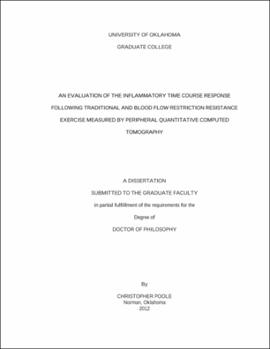| dc.description.abstract | Acute muscle swelling following resistance exercise can increase mCSA when assessed by pQCT. This swelling does not reflect muscle hypertrophy, but rather a fluid shift in and around the exercised musculature that may stimulate protein synthesis. This creates a need for determining the inflammatory time course response following a bout of resistance exercise to pinpoint the earliest a pQCT scan can be performed to predict mCSA with minimal error. Furthermore, the degree of muscle swelling following traditional resistance exercise and blood flow restriction resistance exercise has yet to be compared. PURPOSE: The purpose of this investigation was to determine the time course of increased intramuscular fluid following a traditional high-intensity resistance exercise bout and a low-intensity combined with blood flow restriction resistance exercise bout. METHODS: Ten men, aged 18-30 years, completed three experimental conditions in random order separated by at least one week: traditional resistance exercise [TRE], blood flow restriction resistance exercise [BFR], and a non-exercise control [CON]. For TRE subjects completed three sets of 8-10 repetitions on leg press, leg extension, and leg curl machines at an intensity of 75%-80% 1RM with two minutes of rest allowed between sets and exercises. For BFR, subjects wore five cm wide electronically controlled elastic pressure cuffs around their upper thighs during the exercise bout at a restrictive pressure of 160 mmHg. The same three exercises were completed during BFR but at an intensity of 20% 1RM. Subjects completed 30 repetitions for their first set, followed by three sets of 15 thereafter. Rest intervals were set at 30 seconds. For TRE, subjects remained in resting state, seated for approximately 20 minutes. Prior to exercise and 15 minutes, 75 minutes, 24h, 48h, 72h, and 96h after exercise in TRE and BFR protocols, subjects underwent a pQCT scan and thigh circumference measurement. Additionally, blood samples were collected via finger prick prior to, immediately after, and 1h after exercise to assess plasma volume. Muscle thickness of the quadriceps and hamstring were determined prior to exercise and immediately, 30 min, and 1h after exercise via ultrasound. RESULTS: MTQ for BFR was significantly greater immediately post-exercise (p < 0.001) and 30 minutes post-exercise (p = 0.001) when compared to pre-exercise. MTQ for TRE was significantly greater immediately post-exercise (p = 0.010), 30 minutes post-exercise (p = 0.007), and 60 minutes post-exercise (p = 0.019) when compared to pre-exercise. MTQ for BFR was significantly greater than TRE immediately post-exercise (p = 0.016). MTH for BFR was significantly greater immediately post-exercise (p = 0.036) when compared to pre-exercise. PV%Ä significantly decreased from pre- to immediately post-exercise in both BFR (p < 0.001) and TRE (p < 0.001) conditions. In BFR, mCSA was significantly greater at 15 minutes post-exercise (p < 0.001) and 75 minutes post-exercise when compared to pre-exercise mCSA. In TRE, mCSA was significantly greater at 15 minutes post-exercise compared to pre-exercise mCSA. Thigh circumference was significantly greater at 15 minutes post-exercise in BFR (p < 0.001), TRE (p = 0.002), and CON (p = 0.016) compared to their respective pre-exercise thigh circumference values. Additionally, thigh circumference was significantly greater at 75 minutes post-exercise in BFR (p = 0.032) and TRE (p = 0.007) compared to their respective pre-exercise thigh circumference values. CONCLUSION: Muscle swelling returns to pre-exercise levels within 24 hours after completing a moderate to high volume heavy-resistance exercise bout and a low-intensity coupled with blood flow restriction resistance exercise bout. | |
